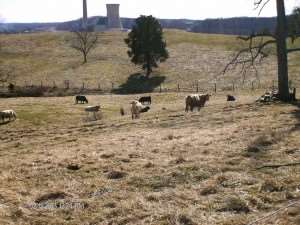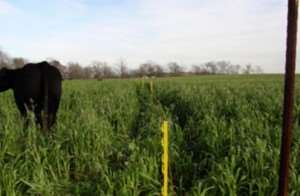By Chris Penrose
Do you have enough feed for this winter? Is it of good quality? If not, there is still time to generate more quality feed for this winter for our cattle. What can we do?

First and foremost, resist the temptation to graze our pastures too close to avoid feeding hay early. When our animals overgraze, bad things happen. Grass that is grazed too close will have to start growing from the roots. Grass not grazed too close can start growing from parts above the ground. If we leave vegetation above the ground, that will help keep cover over the soil and conserve moisture. When do receive rain, more moisture will soak into the soil, especially if we have heavy rains and the ground has some slope. We may be able to still get more growth early this fall that can still be grazed. To take it even a step farther, we also still have time to stockpile fields for grazing hay or pasture fields later in the fall and early winter.

While early August is probably the best time to initiate stockpiling, you will still get a yield and quality response if you apply nitrogen now. Predominately grass fields work best, with fescue being the top choice. For those new to this practice, stockpiling means to make the last harvest, mowing or grazing of a field, then set it aside to let it grow for grazing at a later time. This will provide the plants a chance to rest, build root reserves and produce forages for grazing later in the fall or even winter. The addition of 50 pounds of nitrogen can provide an additional 1000 pounds of dry matter. We did a study where we applied 50 pounds of urea on September 24th and harvested the plots on November 3. The plots with no urea averaged 2290 pounds of dry matter and the plots with 50 pounds of urea averaged 3271 pounds of dry matter, so there is still time. Don’t forget the protein content of the grass will improve as well. One issue with applying the most common form of nitrogen, urea, is that if it does not rain a half of an inch within a couple days when the soil temperatures are still warm, it could start to volatilize or evaporate, losing its effectiveness. The addition of a nitrogen inhibitor when dry weather is forecasted can extend the window to maintain effectiveness for up to two weeks. Another form of nitrogen to consider is di-ammonium phosphate or 18-46-0, if your soil tests also call for the addition of phosphorous. The 18% nitrogen in this fertilizer is more stable than the urea form of nitrogen.
Can you still plant something? The answer is definitely yes. Small grains are still an option. Oats and cereal rye come to mind. They can be planted together or separate. Oats will grow fast and die off after cold weather sets in and cereal rye will grow slower, maintain quality, provide some forage in late fall, then provide early season growth when weather breaks next March. One nice thing about oats is if you have a field that has been grazed close, I have seen successful plantings when simply drilled right into the existing vegetation. If this is done, consider applying fertilizer after the oats have emerged to prevent the existing vegetation from utilizing too much of the fertilizer. Another advantage to planting oats or cereal rye is that it should be high quality to offset potentially low quality hay that we may have.

Finally, will there be any crop residues that can be grazed after harvest? One that is often overlooked is grazing corn residue. According to my co-worker, Rory Lewandowski (November 27, 2013 Ohio Beef Newsletter) between 14-16 pounds of corn residue dry matter is left in the field for every bushel of corn harvested. University of Nebraska has done a lot of work with this and typically, less than one-third is removed from the field from grazing. Another University of Nebraska study conducted from 2004 to 2009 found an average of one bushel per acre of grain was also available for grazing. So while fall is here, we still have a small window to produce and utilize several types of feed for our cattle.

Source: osu.edu